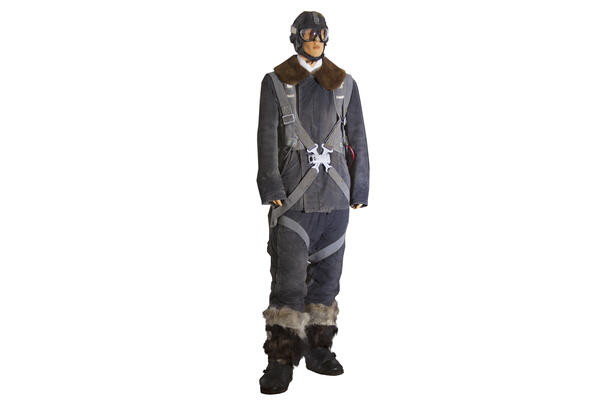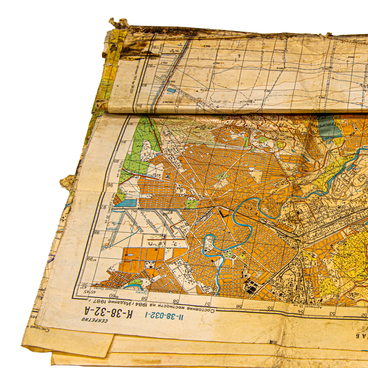During the Great Patriotic War pilots dressed according to the weather: before the advent of jet aircraft flight altitude was not too high, and cockpits were not airtight. In summer they usually wore only a tunic, while in winter they wore a fur jacket and wadded pants. Often awards were hung on the tunic.
In the museum’s exhibition, you can see a pilot winter uniform with a warm jacket. Its collar was furry and could be detached if necessary. . Pilots had to wear fur jackets in winter since there was no heating in the cabin. However, the small space in the cabin warmed up quickly from breathing and body heat, so some aviators did not wear wadded pants.
Feet in winter were insulated with “unts” — special footwear made of leather on a thick sole with a fur lining. The word itself entered the Russian language from the Evenki: unta — “footwear”, “boot”. Classic unts were sewn from deer skin and decorated with pieces of fox or hare skins, colored cloth, or beads. But for pilots, they were usually made of kirzas or leather and fur — they were more like modern ones but looked more massive. The unts were considered the most cold-resistant footwear, so most often pilots of the Soviet Air Force wore them. Helmet and flight goggles were also mandatory pieces of equipment.
Another detail that deserves special attention is the white silk scarf. Silk scarves were introduced to pilots during World War I. Since there were no radars or other airborne long-range enemy detection systems in the cockpit, he had to survey the perimeter on his own to see enemy aircraft in time. Sometimes combat sorties could last several hours, and the need to constantly look to the sides caused the pilots to rub their necks in blood. The silk white scarves were smooth and dense enough to prevent chafing and protect against the oncoming wind.
During World War II, silk scarves were worn mostly by Germans. They were considered a special feature of Luftwaffe pilots. White scarves were much less common in Soviet aviation. However, information has survived that such a scarf was often worn on sorties by a Soviet military pilot, Hero of the Soviet Union, and one of the most famous fighter pilots of the first period of the war, Boris Safonov. Following him, other members of his squadron began to wear white scarves. The practical purpose of silk scarves during World War I had already been forgotten, so pilots were at first skeptical. But thanks to Safonov, Red Army Air Force pilots began to wear them again, although not as massively as before.
In the museum’s exhibition, you can see a pilot winter uniform with a warm jacket. Its collar was furry and could be detached if necessary. . Pilots had to wear fur jackets in winter since there was no heating in the cabin. However, the small space in the cabin warmed up quickly from breathing and body heat, so some aviators did not wear wadded pants.
Feet in winter were insulated with “unts” — special footwear made of leather on a thick sole with a fur lining. The word itself entered the Russian language from the Evenki: unta — “footwear”, “boot”. Classic unts were sewn from deer skin and decorated with pieces of fox or hare skins, colored cloth, or beads. But for pilots, they were usually made of kirzas or leather and fur — they were more like modern ones but looked more massive. The unts were considered the most cold-resistant footwear, so most often pilots of the Soviet Air Force wore them. Helmet and flight goggles were also mandatory pieces of equipment.
Another detail that deserves special attention is the white silk scarf. Silk scarves were introduced to pilots during World War I. Since there were no radars or other airborne long-range enemy detection systems in the cockpit, he had to survey the perimeter on his own to see enemy aircraft in time. Sometimes combat sorties could last several hours, and the need to constantly look to the sides caused the pilots to rub their necks in blood. The silk white scarves were smooth and dense enough to prevent chafing and protect against the oncoming wind.
During World War II, silk scarves were worn mostly by Germans. They were considered a special feature of Luftwaffe pilots. White scarves were much less common in Soviet aviation. However, information has survived that such a scarf was often worn on sorties by a Soviet military pilot, Hero of the Soviet Union, and one of the most famous fighter pilots of the first period of the war, Boris Safonov. Following him, other members of his squadron began to wear white scarves. The practical purpose of silk scarves during World War I had already been forgotten, so pilots were at first skeptical. But thanks to Safonov, Red Army Air Force pilots began to wear them again, although not as massively as before.



